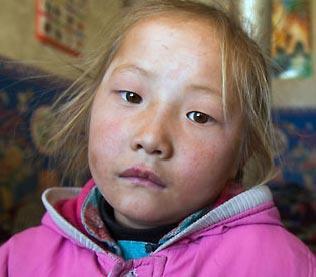|
Saturday, February 03, 2007
 The Daily Telegraph has an interesting article titled Roman descendents found in China? The girl to the left is one of many individuals in the city of Liqian who exhibit more conventially European features (e.g., londe hair) mixed in with a typical Han phenotype. The article floats the idea that these individuals are derived from a settlement of Roman soldiers, who were originally captured during the defeat of Marcus Licinius Crassus at the Battle of Carrhae. At this period the soldiers in the Roman army were generally from Rome proper. The article notes that researchers have taken DNA samples from 93 local individuals, so if these traits are evidence of Roman ancestry we'll find out pretty easily because Italians carry West Eurasian haplotypes which should stand out pretty easily. The Daily Telegraph has an interesting article titled Roman descendents found in China? The girl to the left is one of many individuals in the city of Liqian who exhibit more conventially European features (e.g., londe hair) mixed in with a typical Han phenotype. The article floats the idea that these individuals are derived from a settlement of Roman soldiers, who were originally captured during the defeat of Marcus Licinius Crassus at the Battle of Carrhae. At this period the soldiers in the Roman army were generally from Rome proper. The article notes that researchers have taken DNA samples from 93 local individuals, so if these traits are evidence of Roman ancestry we'll find out pretty easily because Italians carry West Eurasian haplotypes which should stand out pretty easily.Of course, I think a more plausible guess is these individuals are simply part of the normal range of variation on the Western borders of China, which was inhabited byEuropean looking peoples like Tocharians until relatively recently. Additionally, during the rise of the Mongol Empire whole villages were transferred from the west to the east, and whole contingents of groups like the Alans (from the North Caucasus) were to be found in the Mongol ruled cities of North China. So, it is also possible that as opposed to ancient Romans, these individuals descend from transplants who arrived during the period the Pax Mongolica. A final point which I would like to emphasis is that the East Asian ecotype which we recognize as dominant in that region of Eurasia is actually a relatively recently phenomenon. The expansion of rice and wheat farmers from the North China plain, or the settlement of Japan from Korea within the last 2,000 years, as smothered (I suspect) a great deal of morphological variation in Eastern Eurasia, and "atypical" peoples and individuals might simply be remnants of the ancient range of variation before the demic expansion of "Classic Mongoloids" starting about 8-10,000 years ago. |



